Scrapbooking can be a powerful tool for mental wellness. Start by selecting meaningful photos and mementos that resonate with your emotions. Create a safe, comfortable space for your crafting. Express your feelings through color choices and experiment with various textures to engage your senses. Incorporate positive affirmations and practice mindfulness while you work. Use journaling for self-reflection and to process your thoughts. Don't forget to celebrate small victories in your scrapbook. Sharing your creations with trusted friends can provide additional support. By exploring these techniques, you'll access the full therapeutic potential of scrapbooking for your mental health journey.
Choose Meaningful Photos and Mementos

Most scrapbooking journeys begin with selecting the right photos and mementos. As you initiate this therapeutic process, choose images and items that resonate with your emotions and experiences. Look for photographs that capture significant moments, both joyful and challenging. These visual reminders can help you process and reflect on your life's journey.
Don't limit yourself to just photos. Include ticket stubs, letters, or small trinkets that hold special meaning. These tangible objects can evoke powerful memories and emotions, adding depth to your scrapbook pages. As you sift through your collection, pay attention to how each item makes you feel. Select those that spark strong emotions or represent important milestones in your personal growth.
Consider organizing your chosen items chronologically or thematically. This approach can help you see patterns in your experiences and track your progress over time.
Create a Safe Space
With your meaningful photos and mementos selected, it's time to set up a dedicated space for your scrapbooking journey. Creating a safe, comfortable environment is essential for your mental wellness and creative process.
Choose a quiet area in your home where you can work undisturbed and feel at ease. This space should be well-lit, organized, and free from distractions.
Ensure your scrapbooking sanctuary has these fundamental elements:
- A sturdy table or desk with ample workspace
- Comfortable seating that supports good posture
- Storage solutions for your supplies and materials
- Proper lighting, preferably natural light or adjustable lamps
- A soothing ambiance with calming colors or decor
Personalize your space to reflect your style and inspire creativity. Consider adding elements that bring you joy, such as plants, artwork, or calming music.
Keep your area clutter-free and organized to minimize stress and maximize productivity. By creating a safe, dedicated space for scrapbooking, you're setting the stage for a therapeutic and enjoyable experience.
This environment will allow you to focus on your memories and emotions, promoting healing and self-discovery through your creative process.
Express Emotions Through Colors
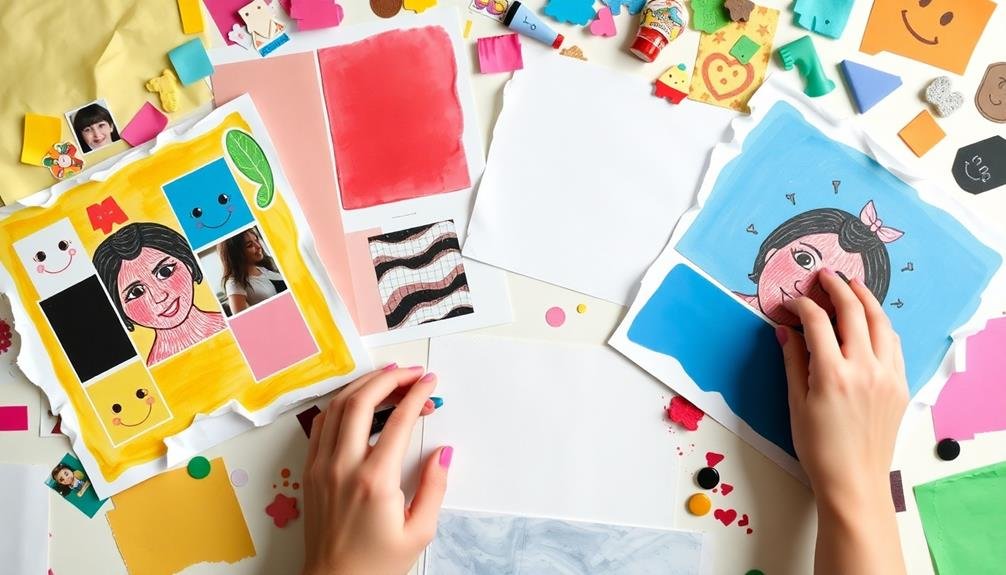
Colors play a pivotal role in expressing emotions through scrapbooking. They can evoke powerful feelings and help you convey your state of mind without words. When choosing colors for your scrapbook pages, consider their psychological impacts. Warm hues like red, orange, and yellow often represent energy, passion, and happiness. Cool tones such as blue, green, and purple typically symbolize calm, growth, and introspection.
Don't be afraid to experiment with color combinations that resonate with your emotions. You might use bright, vibrant colors to express joy or excitement, while muted or dark shades could represent sadness or anger. Consider creating a personal color code to track your moods over time. This can help you identify patterns in your emotional well-being.
Remember that color intensity matters too. Bold, saturated colors can convey strong emotions, while pastels might represent gentler feelings. You can also use color gradients to show emotional shifts or conflicting feelings.
Incorporate Positive Affirmations
You can boost your mental wellness by incorporating positive affirmations into your scrapbooking practice.
Try crafting affirmation cards with encouraging messages and decorative elements to reinforce self-love and confidence.
You'll also benefit from including daily positive mantras in your layouts, serving as gentle reminders of your worth and potential throughout your scrapbooking journey.
Craft Affirmation Cards
Affirmation cards serve as powerful tools in your scrapbooking journey toward mental wellness. By crafting your own, you'll create personalized reminders of your strengths and goals. Start by selecting cardstock or thick paper in colors that resonate with you. Write positive statements that address specific areas of your life you'd like to improve or maintain. Use bold, clear lettering to make your affirmations stand out.
Enhance your affirmation cards with:
- Decorative borders or frames
- Inspiring images or photographs
- Colorful stickers or washi tape
- Meaningful quotes or mantras
- Textured elements like fabric or ribbons
Incorporate these cards into your scrapbook layouts, placing them strategically to reinforce positive thoughts. You can also create a separate section dedicated to affirmations, allowing you to flip through them whenever you need a boost.
As you craft these cards, focus on the present moment and the positive emotions they evoke. Remember, the act of creating affirmation cards is therapeutic in itself, helping you internalize these empowering messages.
Daily Positive Mantras
Incorporating daily positive mantras into your scrapbooking practice can greatly enhance your mental wellness journey. Choose mantras that resonate with you and align with your personal goals. Write them on decorative paper or create digital designs, then add them to your scrapbook pages. You can also create a dedicated mantra section in your scrapbook for easy reference.
Rotate your mantras regularly to keep them fresh and impactful. Consider themes like self-love, gratitude, or resilience. For example, "I am worthy of love and respect" or "I embrace challenges as opportunities for growth." As you craft, repeat these mantras to yourself, allowing their positive energy to infuse your creative process.
Experiment with different fonts, colors, and embellishments to make your mantras visually appealing. You might pair them with relevant photos or symbols that reinforce their meaning.
Don't forget to date your mantras to track your progress over time. By consistently incorporating these positive affirmations into your scrapbooking, you'll create a powerful tool for self-reflection and personal growth, fostering a more positive mindset and improved mental well-being.
Practice Mindfulness While Crafting
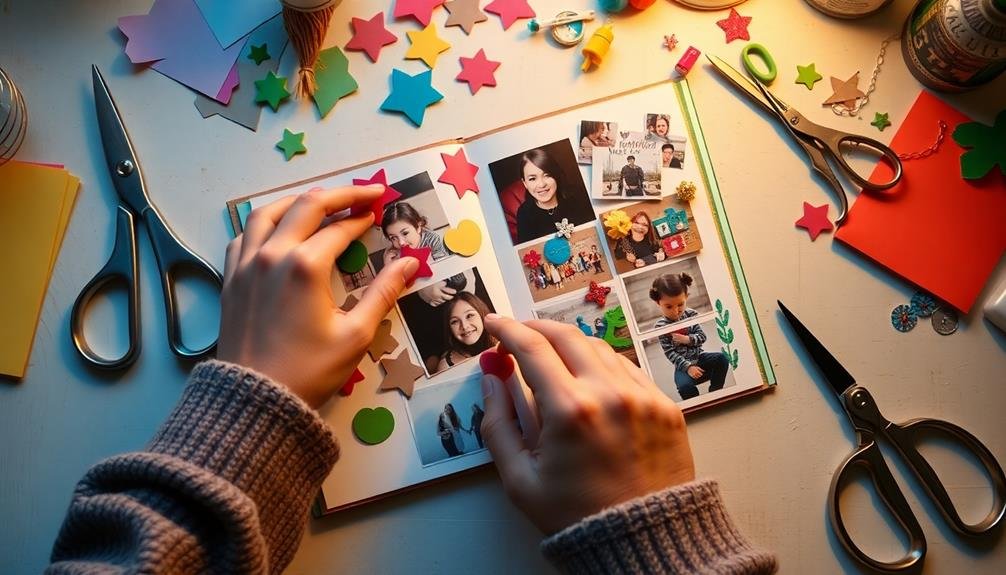
Mindfulness and crafting form a powerful duo in the domain of scrapbooking for mental wellness. As you engage in this creative process, focus on being present in the moment. Pay attention to the textures of paper, the scent of glue, and the vibrant colors of your materials.
This mindful approach can help you reduce stress and anxiety while boosting your overall well-being.
To practice mindfulness while scrapbooking:
- Take deep breaths before starting your project
- Notice the sensations in your hands as you work
- Observe your thoughts without judgment
- Focus on one task at a time, avoiding multitasking
- Appreciate the creative process, not just the end result
Document Personal Growth Journey
Scrapbooking offers a unique way to document your personal growth journey.
You can track your progress visually by creating pages that showcase your achievements, reflect on life lessons through journaling, and celebrate personal milestones with special layouts.
This creative process allows you to see how far you've come and motivates you to continue your path of self-improvement.
Track Progress Visually
Through visual documentation, you can effectively track your personal growth journey in a scrapbook. Create a timeline of significant events, milestones, and personal achievements. Use photographs, drawings, or symbols to represent each step of your progress. This visual representation allows you to see how far you've come and serves as a powerful reminder of your resilience and growth.
Consider incorporating these elements to track your progress visually:
- Before and after photos to showcase physical or emotional changes
- Graphs or charts depicting improvements in specific areas of your life
- Inspirational quotes that resonate with your journey at different stages
- Ticket stubs, postcards, or mementos from meaningful experiences
- Color-coded entries to represent different emotions or levels of progress
As you flip through your scrapbook, you'll notice patterns and trends in your personal development. This visual tracking method can boost your motivation and self-esteem, especially during challenging times.
It provides tangible evidence of your growth and serves as a source of encouragement to continue your healing journey. Remember to update your scrapbook regularly and celebrate even the smallest victories along the way.
Reflect on Life Lessons
Documenting life lessons in your scrapbook can be a powerful way to reflect on your personal growth journey. As you create pages dedicated to important life lessons, you'll gain valuable insights into your experiences and how they've shaped you.
Start by identifying key moments or challenges that taught you something significant. Then, use a combination of photos, journaling, and meaningful quotes to capture the essence of each lesson.
Don't shy away from including both positive and difficult experiences. The goal is to show your evolution and resilience. Consider creating before-and-after layouts to visually represent your growth. You might include photos of yourself at different stages, along with written reflections on how your perspective has changed.
Use prompts to guide your reflection, such as "What did I learn from this experience?" or "How has this lesson impacted my life?" Be honest and vulnerable in your journaling, as this will make your scrapbook more meaningful and authentic.
Celebrate Personal Milestones
Personal growth milestones are the stepping stones of your mental wellness journey, and celebrating them in your scrapbook can boost your self-esteem and motivation. As you document your progress, you'll create a visual reminder of how far you've come and inspire yourself to keep moving forward.
To effectively celebrate personal milestones in your scrapbook:
- Choose a consistent format for milestone pages, making them easy to recognize
- Include before-and-after photos or tangible representations of your progress
- Write detailed descriptions of the challenges you've overcome
- Add motivational quotes or personal mantras that resonate with your journey
- Involve friends or family by including their supportive messages or signatures
Don't limit yourself to big achievements; celebrate small wins too. Whether it's maintaining a daily meditation practice for a week or successfully maneuvering a difficult social situation, every step counts.
As you flip through your scrapbook, you'll see a clear pattern of growth and resilience. This visual representation of your progress can serve as a powerful tool when you're facing new challenges or feeling discouraged.
Use Journaling for Self-Reflection
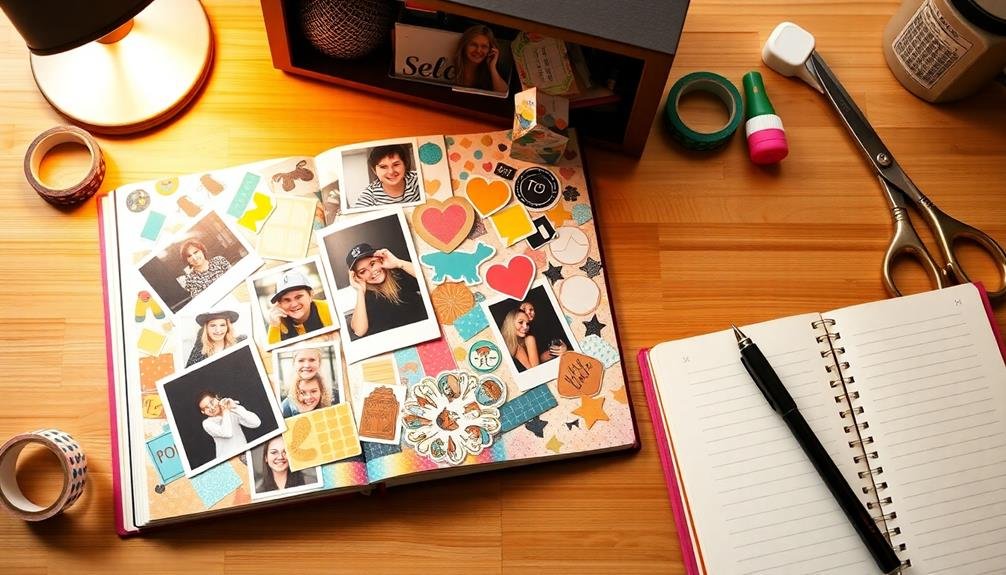
Journaling within your scrapbook opens up a world of self-reflection and personal growth. As you create layouts, include dedicated spaces for writing about your thoughts, feelings, and experiences. This practice allows you to process emotions, gain insights, and track your progress over time.
When journaling in your scrapbook, consider these techniques:
| Prompt Type | Examples | Benefits |
|---|---|---|
| Gratitude | List 3 things you're thankful for | Improves mood and outlook |
| Goal-setting | Write down short and long-term goals | Increases motivation and focus |
| Reflection | Describe a recent challenge and lessons learned | Enhances problem-solving skills |
| Affirmations | Write positive statements about yourself | Boosts self-esteem and confidence |
| Free-writing | Express thoughts without judgment | Reduces stress and anxiety |
Don't worry about perfect prose; focus on honest expression. Use different colored pens or markers to highlight emotions or themes. You can even create secret pockets for more private reflections. Remember, your scrapbook is a safe space for self-discovery and healing. By combining visual elements with written introspection, you're creating a powerful tool for mental wellness and personal growth.
Experiment With Different Textures
Experimenting with different textures in your scrapbook can engage your senses and enhance the therapeutic experience.
You'll find creative ways to mix materials like fabric, ribbons, and textured paper to add depth and interest to your pages.
Explore Tactile Sensations
Tactile exploration forms an essential part of the scrapbooking experience for mental wellness. As you create your pages, focus on the various textures you can incorporate to engage your sense of touch. This mindful approach can help ground you in the present moment and provide a soothing sensory experience.
Consider adding these tactile elements to your scrapbook:
- Soft fabrics like velvet or silk
- Rough textures such as sandpaper or burlap
- Smooth surfaces like glass beads or polished stones
- Natural materials including leaves, flowers, or bark
- Dimensional elements like buttons, ribbons, or embossed paper
As you work with these materials, pay attention to how they feel against your fingertips. Notice the contrast between smooth and rough surfaces, or the way different fabrics drape and fold.
This sensory engagement can help reduce stress and anxiety, allowing you to focus on the present moment. Experiment with layering different textures to create depth and interest in your scrapbook pages.
Don't be afraid to mix and match unexpected combinations – the process of discovery can be just as therapeutic as the final result.
Mix Materials Creatively
Building on the idea of tactile exploration, let's embrace the art of mixing materials creatively in your scrapbook. Experiment with different textures to enhance your emotional connection to the pages and stimulate your senses. Combine smooth paper with rough burlap, or pair glossy photos with matte cardstock.
Try incorporating fabric swatches, ribbons, or lace for a soft touch. Don't limit yourself to traditional scrapbooking materials. Add pressed flowers, dried leaves, or small pebbles to evoke memories of nature walks. Use metallic elements like foil, glitter, or sequins to create visual interest and catch the light.
Experiment with unconventional items like sandpaper, cork, or even small pieces of wood for unique textures. Consider the emotional impact of each material. Soft textures might soothe anxiety, while rougher surfaces could ground you during moments of stress.
Play with transparent overlays or vellum to create depth and layers in your designs. Remember, there's no right or wrong way to mix materials – let your intuition guide you. This creative process can be deeply therapeutic, allowing you to express complex emotions through tactile experiences.
Texture for Emotional Expression
Textures speak volumes in the language of emotions. As you create your scrapbook pages, consider how different textures can represent your feelings and experiences. Rough surfaces might convey struggle or turmoil, while smooth textures could symbolize calm and peace.
Experiment with various materials to add depth and meaning to your layouts. Incorporate textures that resonate with your emotional state:
- Sandpaper for gritty, challenging times
- Velvet for comfort and luxury
- Burlap for rustic, down-to-earth moments
- Silk for smooth changes or gentle experiences
- Corrugated cardboard for ups and downs in life
Don't limit yourself to paper-based textures. Try incorporating fabric swatches, ribbons, or even natural elements like pressed leaves or flowers.
These tactile elements can trigger memories and evoke powerful emotions as you create and revisit your scrapbook pages.
Celebrate Small Victories
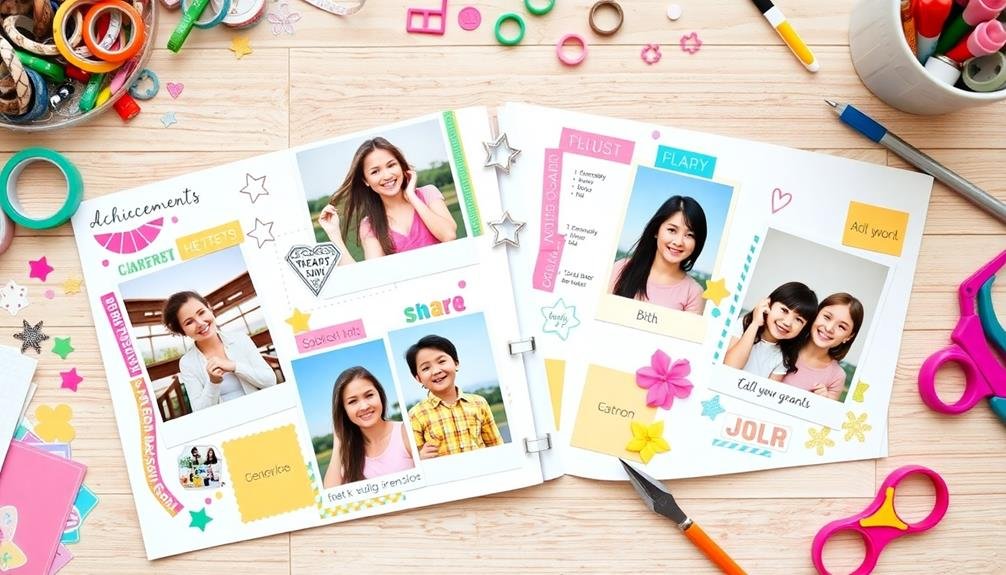
Celebrating small victories is a significant aspect of scrapbooking for mental wellness. It's easy to overlook minor accomplishments, but they're essential for building self-esteem and motivation. As you create your scrapbook pages, focus on capturing moments that represent personal growth, no matter how small.
Use your scrapbook to document and celebrate these achievements:
| Achievement Type | Examples |
|---|---|
| Daily Tasks | Making your bed, cooking a meal |
| Self-Care | Taking a relaxing bath, meditating |
| Social Progress | Initiating a conversation, attending an event |
| Work/Study | Completing an assignment, learning a new skill |
| Personal Growth | Overcoming a fear, trying something new |
Share Your Scrapbook Story
Sharing your scrapbook story can be a powerful step in your healing journey. It allows you to connect with others, gain new perspectives, and find support in your mental wellness journey.
When you're ready, consider sharing your scrapbook with trusted friends, family members, or support groups. This act of vulnerability can lead to deeper connections and understanding.
Remember, you're in control of how much you share and with whom. Start small if you're hesitant, perhaps by showing just a few pages or explaining a single layout.
As you become more comfortable, you might:
- Join online scrapbooking communities to share digital versions
- Host a small gathering to showcase your work
- Collaborate with others on a group scrapbook project
- Use your scrapbook as a conversation starter in therapy sessions
- Create a blog or social media account dedicated to your scrapbooking journey
Frequently Asked Questions
How Can Scrapbooking Help With Specific Mental Health Conditions Like Depression or Anxiety?
Scrapbooking can help with depression and anxiety by providing a creative outlet. You'll focus on positive memories, practice mindfulness, and boost self-expression. It's a calming activity that can reduce stress and improve your mood.
Are There Any Risks or Potential Drawbacks to Using Scrapbooking for Healing?
While scrapbooking can be therapeutic, you should be aware of potential drawbacks. It might trigger painful memories, become an obsessive habit, or lead to perfectionism. Don't use it as a substitute for professional help if you're struggling with serious issues.
Can Digital Scrapbooking Be as Effective as Traditional Paper-Based Methods?
Yes, digital scrapbooking can be just as effective as traditional methods. You'll still engage creatively and process emotions. It's convenient, allows easy editing, and offers unique design options. Choose whichever format you're most comfortable with for the best results.
How Often Should One Engage in Scrapbooking for Optimal Mental Health Benefits?
You'll benefit most by scrapbooking regularly, but there's no one-size-fits-all schedule. Aim for at least once a week, or whenever you feel stressed. Listen to your needs and make it a consistent part of your self-care routine.
What Role Can Group Scrapbooking Sessions Play in the Healing Process?
Group scrapbooking sessions can enhance your healing process. You'll share experiences, learn new techniques, and build supportive relationships. They'll provide a sense of community, boost creativity, and offer a safe space for emotional expression and growth.
In Summary
You've now discovered powerful ways to heal through scrapbooking. Remember, it's not about perfection but the process. As you craft, you're rebuilding your story and nurturing your mental wellness. Don't be afraid to experiment and make it personal. Your scrapbook is a reflection of your journey and growth. Keep at it, and you'll find that with each page, you're not just preserving memories, but also creating a brighter, more resilient you.

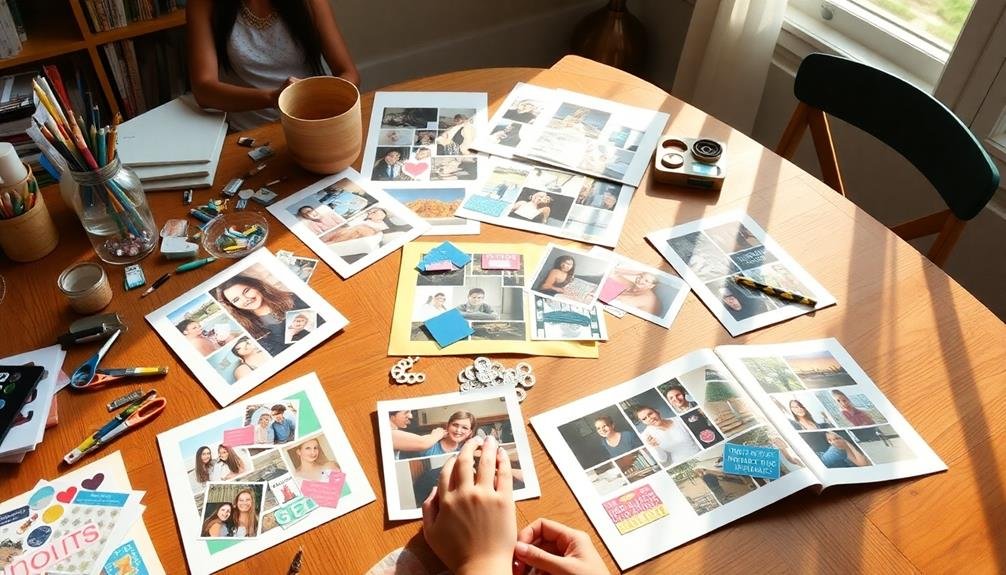



Leave a Reply